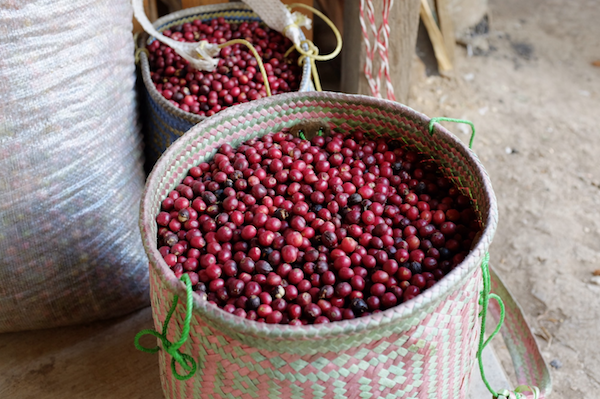Learn how to set up your own triangulation cupping to improve your coffee tasting abilities! A triangulation involves sets of three bowls, one of which is unique, and it's your job to detect the anomaly. The faster you can do this the better. You can adjust the difficulty by using coffees that are more or less similar to each other.
Read MoreWe have been using this video for educational staff trainings but thought it might be beneficial for our customers to see as well. This footage was shot during our 2022 visit to Catalan de las Mercedes in Guatemala where we purchase coffee every year. If you’ve ever wondered about how coffee is grown and processed at farm level, this is the video for you!
Read MoreThe growth of operations at Catalan De Las Mercedes astounded us this year! Two years of travel restrictions only serve to amplify the feeling of amazement when returning to this farm. Producer Nico Hammond has transformed this third generation farm into an enormous operation, with new additions including a fully staffed school center for harvest workers complete with dormitories and a large scale mechanical drying facility. Among the many efforts toward sustainability, the excess water from the mill is used to irrigate grasslands where livestock graze. They also recycle the cherry pulp into organic compost.
Read MoreHere’s a trick for iced coffee that will create a more refreshing, crisp beverage than cold brew and can even be scaled up to a batch brewer!
Read MoreStep-by-Step Guide: How to Make Cold Brew at Home. You will need: coffee, filtered water, brewer, scale and grinder.
Read MoreIn a time where coffee and convenience seem to go hand in hand, many people would probably be surprised to know just how hard it is to get this product to them. Let’s start with the fact that higher quality coffee production excels in places with predictable dry and rainy seasons, requiring elevations over 800 masl and as high as 3,000 masl.
Read MoreThe exact story of coffee’s earliest entry into the human diet has faded well beyond the reach of history, but modern geneology has given us the ability to trace the origins of the fruit to the western mountains of Ethiopia. What’s clear is that at some point, people took a liking to the fruit of the shade-loving trees growing wild under the forest canopy, and decided to plant the seeds with them where they settled.
Read MoreStep-by-step pour over guide for at-home brewers or anyone who wants to learn the secrets of the V60. You will need: kettle, paper filter, scale, grinder, decanter, brewing cone, timer, coffee, filtered water (205 F).
Read MoreUnderstanding the fundamentals of extraction will make you a better brewer. Of all the gadgets our shops incorporate, one of the tiniest and most unassuming is among the most valuable tools a barista can have: the refractometer.
Read MoreBrew cafe-quality coffee at home with these easy step-by-step instructions. A few small tweaks to your routine will take your coffee experience to the next level and ensure the most flavorful, balanced cup every time.
Read MoreStanding out of the way in the Roman-Lopez family’s courtyard, we watched quietly and learned how locals near Teojomulco, Oaxaca practice delivering and receiving coffee. The Roman-Lopez’s courtyard functions as the local bodega (warehouse) where small scale growers bring their coffee already dried in parchment, which is weighed on arrival and paid for by the Roman-Lopez’s who eventually pool tiny local lots together and handle the next stage of transportation to dry milling.
Read MoreWe’re pleased to release our lot from the Sierra Mixteca Cooperative this week, despite unforeseen delays in its arrival to the US. This February, 2018, Christina Chin and I had the pleasure of visiting with this group of small producers who were finishing their harvest for the year, which helps us paint a clearer picture of this coffee’s story.
Sierra Mixteca is a mountain range situated in the northern part of Oaxaca, and this coffee comes directly from the community of in the smaller region of Yucihiti. The Mixtec people are one of the dozens of culturally distinct indigenous communities living predominantly in Oaxaca, Guerrero, and Puebla states. In the town of Miramar, Yucihiti, the Cooperativo Sierra Mixteca was formed in 2012 to provide local farmers with better leverage in the export market. It also enables them to centralize aspects of processing, transportation, and storage, as well as providing them with extra access to financing.
Made up of 140 members, most of these farmers operate very small farms of .5–3 hectares, where the vast majority of labor is performed by the farming families with little to no additional workers. They are committed to Organic farming. We visited with two such families who we’re profiling here.
Read MoreTerroir: Characteristics which correlate to the soil where a coffee grew. There is a wide range of specificity here. Terroir characteristics can be thought of as broadly as “A Brazilian profile has low acidity and tastes malty” — or — as specifically “this part of a farm has slightly different soil composition, and tastes different than another part of the farm planted with the same varietal.” Somewhere in the middle it’s probably most relevant to be able to identify different regional profiles within a country to understand and appreciate just how vast the endless variety of tastes can go when talking about terroir.
Varietal: The taxonomic classification after species. Coffee has two species, Robusta and Arabica. Coffee varietals can be thought of as stemming from the heirloom varietal(s) growing in western Ethiopia. Over time through natural mutation, natural selection, and deliberate hybridization, the number of varietals increased. Currently the number of coffee varietals is expanding rapidly as farmers continue to experiment and hybridize. Read more about specific varietal tastes here.
Species: There are two species of the genus Coffea, called Coffea Arabica and Coffea Canephora — more commonly called, Robusta. There are many varietals which descend from both species. Robusta is more productive and disease resistant, with less pleasant taste and high caffeine content.
Read MoreProducer: Nicholas Hammond
Region: San Martin Jilotepeque, Chimaltenango, Guatemala
MARCH 2018
Returning to Catalan De Las Mercedes this year, I was most struck by the expansive efforts of Nico Hammond over the last year. The farm’s robust, four year-old wet mill dominates the bottom of a slope facing the farmhouse. Above it, farther up the hill, you catch a glimpse of the top of the farm, which largely faces west. Only 32 hectares of 300 hectares are planted at the moment, and with over 80,000 young trees nearly ready to plant, Nico’s plans for the future are easy to grasp. The farm traditionally grows Red & Yellow Bourbons, but in the nursery you’ll find Pacamara, Maragogipe, and Geisha as well, which reflect evolving tastes and wisely cautious planning. All three are roya resistant, with Pacamara and Geisha known for exciting profiles and high cupping scores.
Read More















